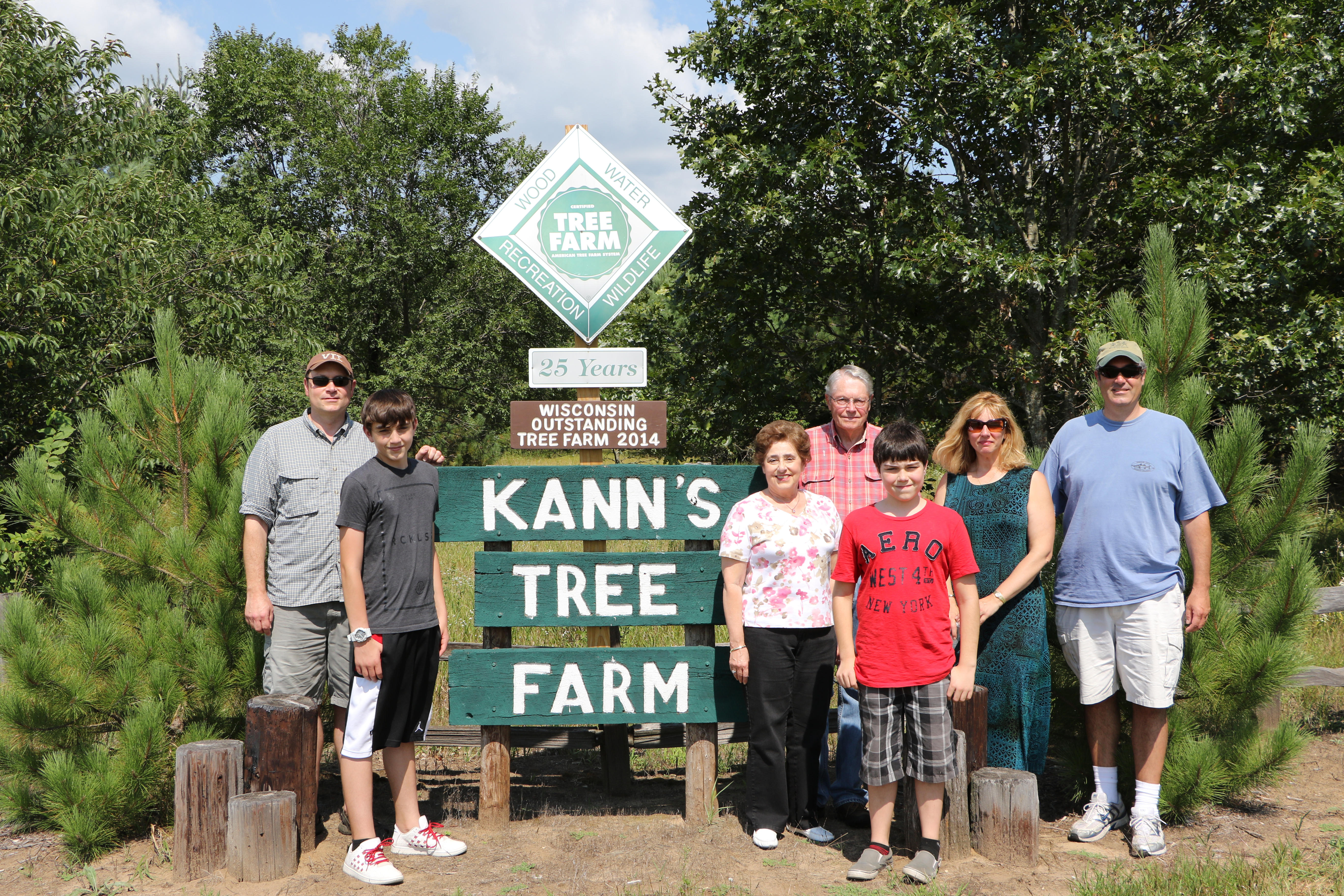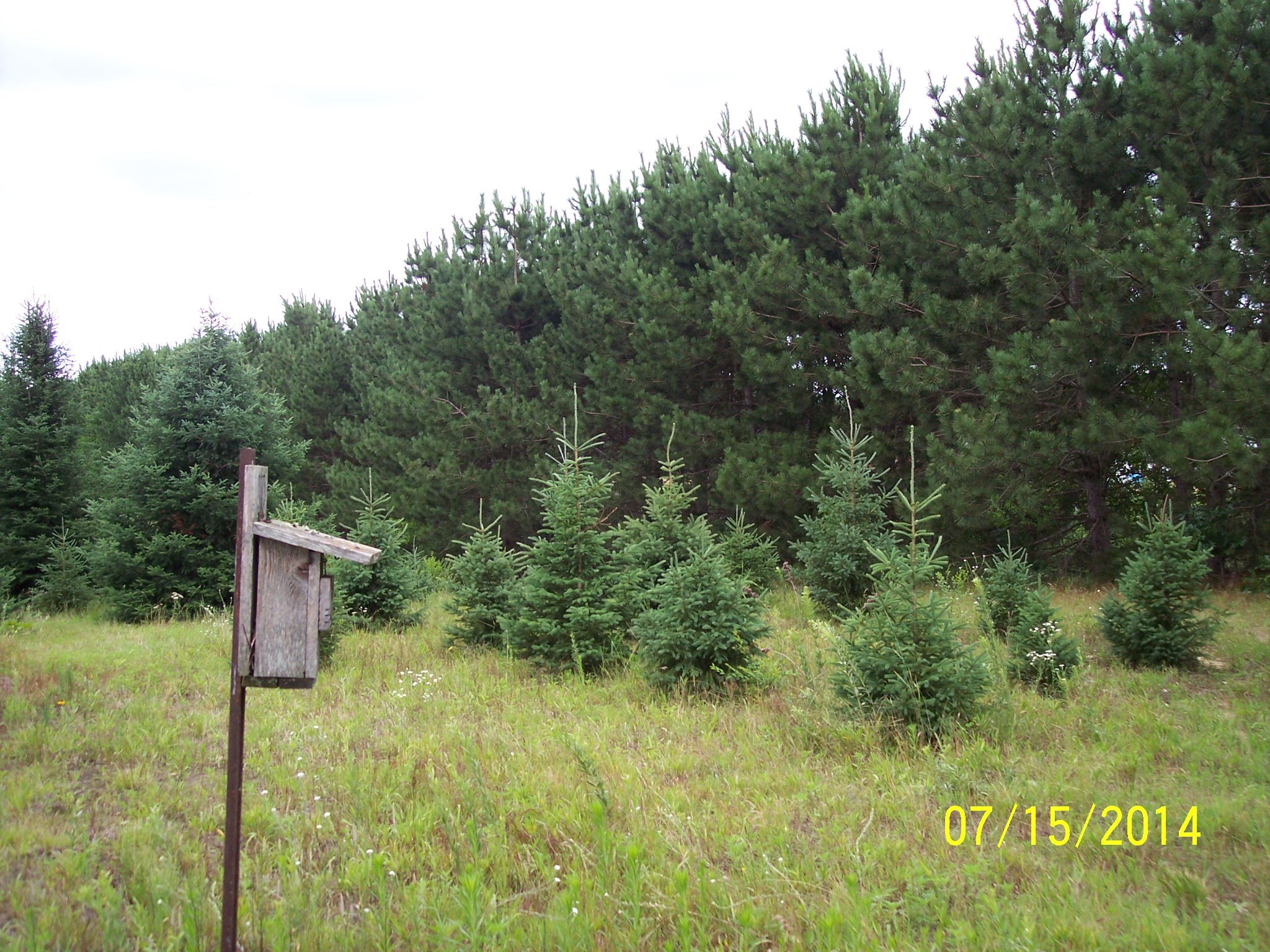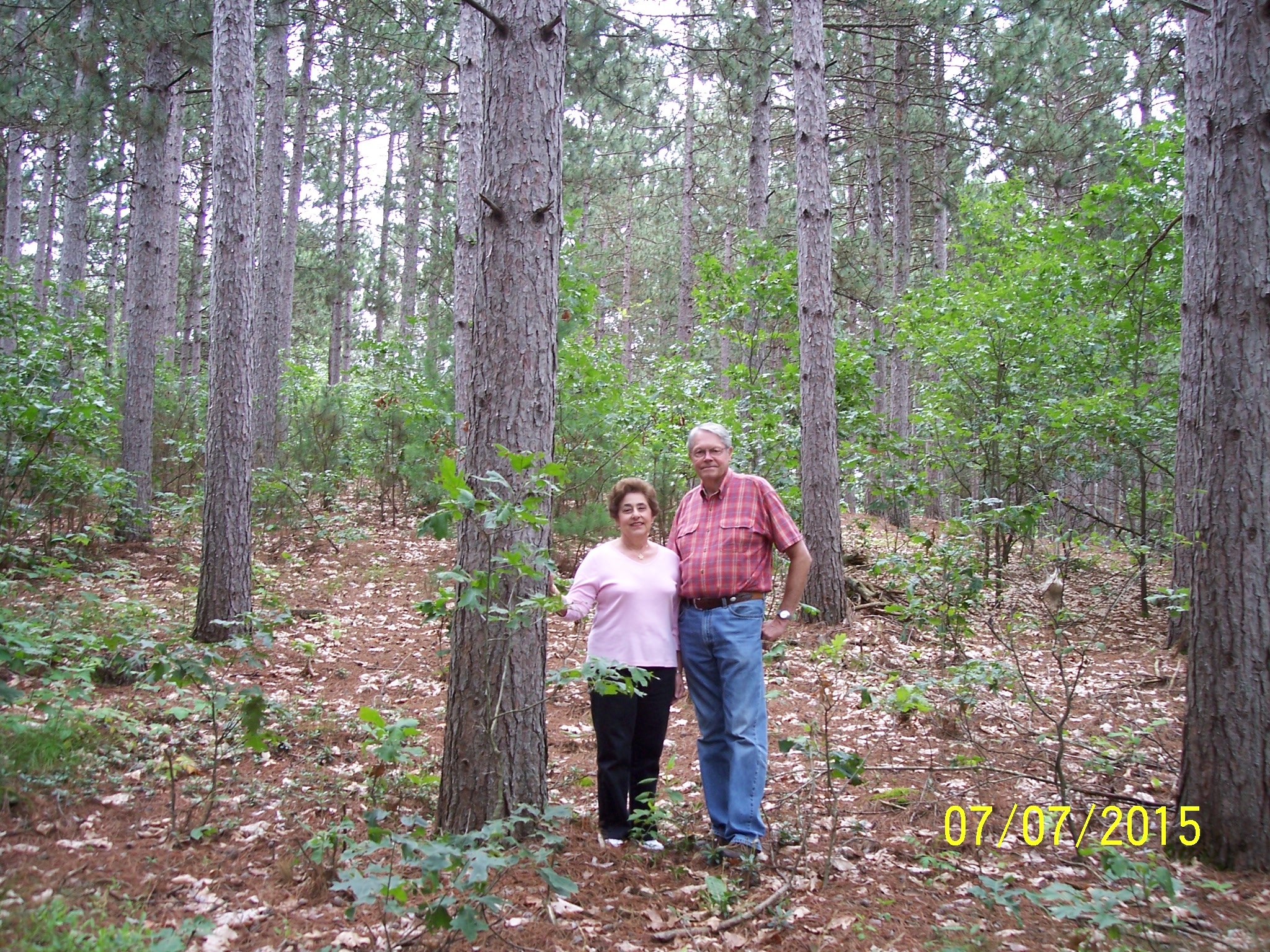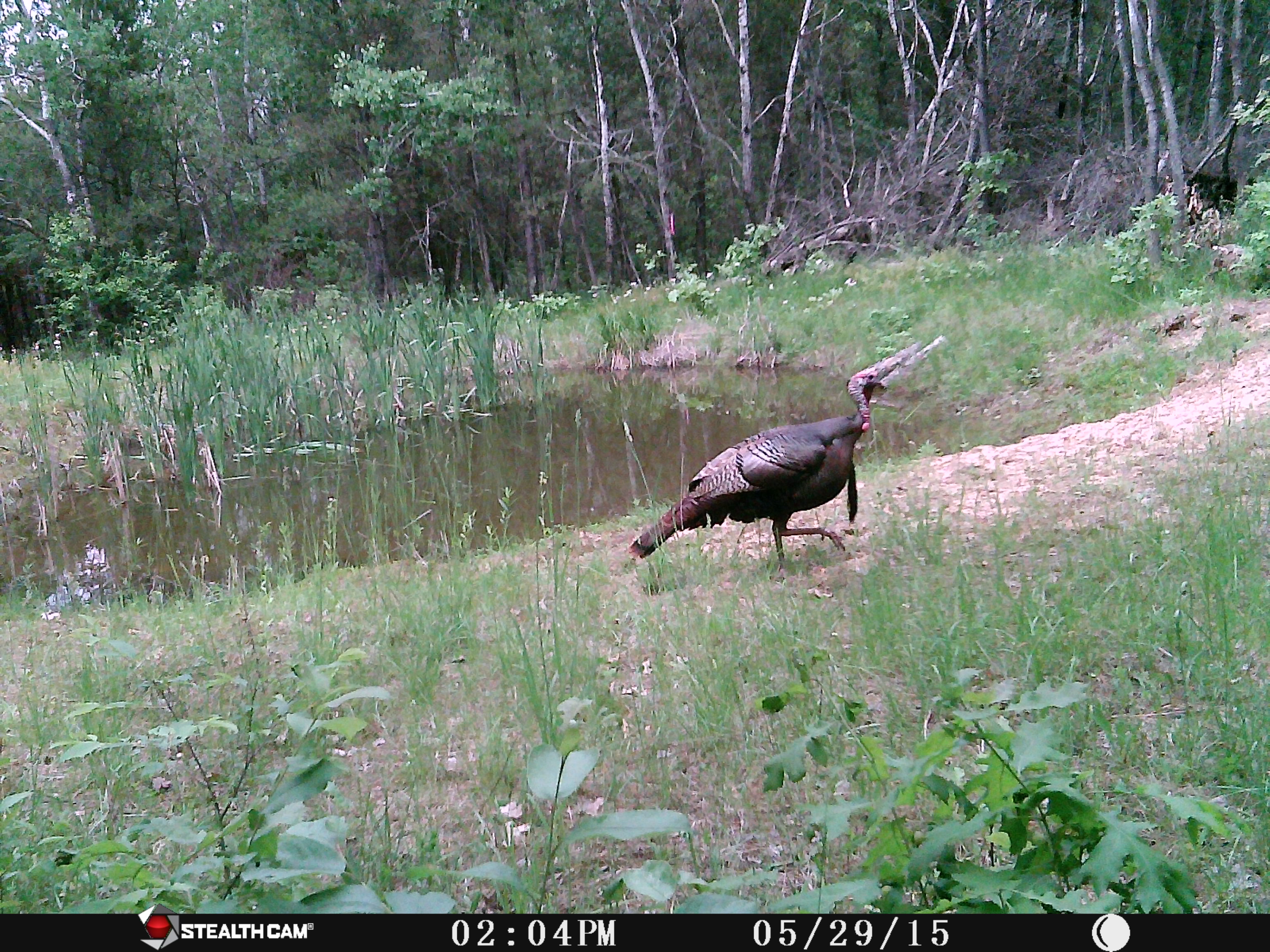Gerald and Charlotte Kann from Wisconsin

What makes them outstanding?
Gerald (Jug) and Charlotte Kann’s Tree Farm is outstanding and unique due to the land stewardship values of the landowners and their work ethic, desire and ability to follow each piece of natural resource professional advice and written management plan with attention to the details. The original 80 acres of Kann’s Tree Farm was purchased by Jug over 40 years ago in 1973.
As soon as Jug purchased his property he contacted natural resource professionals requesting advice and assistance with managing the land. The first management plan of record was Soil Conservation Plan prepared in 1975. There have been several tree planting plans and three other forest management plans prepared on the property over the years using the technical advice and assistance from county, state, and federal agencies. Kann’s sons and friends assisted with some of the tree planting projects as well as some of the building projects. And private consultants and/or contractors were consulted and hired to complete other practices that have occur each year on this tree farm. The Kann’s Tree Farm is an excellent example of the American Tree Farm Program’s values showcased in conducting sustainable forest management through timber harvests and tree planting practices, enhancing wildlife habitat by establishment and maintenance of awildlife food plot and a wildlife pond, and maintaining a trail system on the Tree Farm with little to no soil erosion.
The Kann’s are active member in the American Tree Farm Program as well as members of conservation and community organizations. Through the communityorganizations and the several business ventures Jug Kann has had during his workingcareer, he has been an advocate of the American Tree Farm Program sharing his treeplanting experience, and Tree Farm ownership with others. This has influenced some of his contacts to pursue forest landownership or planting trees to enhance their properties.
Tree Farmer Story
 Jug grew up in the country and had a love of nature. He dreamed ofsomeday owning some land, hoping for 10 acres or so. An opportunity came to purchase 80 acres of land north of Sparta, WI that was part of a run-down 120 acre farm. Having acquired that property in October of 1973, he immediately sought the advice of a DNR forester for a plan for the 68 acres of woodland and a management plan from the Department of Agriculture, Soil Conservation Service for the 12 acres of open land.
Jug grew up in the country and had a love of nature. He dreamed ofsomeday owning some land, hoping for 10 acres or so. An opportunity came to purchase 80 acres of land north of Sparta, WI that was part of a run-down 120 acre farm. Having acquired that property in October of 1973, he immediately sought the advice of a DNR forester for a plan for the 68 acres of woodland and a management plan from the Department of Agriculture, Soil Conservation Service for the 12 acres of open land.
In the Spring of 1974 the Kann family began planting red and white pineconducive to the sandy soil. Thus began Jug's passion for planting trees. Trees tha twere to be thinned were sheared and in 1980 were sold as Christmas trees. The open landwas then converted into a Christmas tree plantation. A log cabin was constructed by Jug and friends in 1990 using red pine from the farm for the purlins. The cabin servedas a place to serve cider for choose and cut tree operation. The site was recognized aspart of a field trip for the National Christmas Tree Association meeting in 1994. The cabin is now used during deer and turkey hunting seasons with family and friends andalso for hosting group picnics.
In 1984, the balance of the 120 acre farm was purchased and added 40 acres to thetree farm. Included in that acquisition was a dumping ground in the woods for old carbodies, snowmobiles, stoves etc. Jug's son Karl, with the help of his hunting friends,took it upon themselves to clean it up. Today, not a trace of the dump exists. Afterselling Christmas trees for 25 years, in 2007 that land was converted into a coniferplantation of red pine and white spruce using a Forest Stewardship management planunder the Wisconsin Forest Landowner Grant Program. The proper practices wereutilized in the planting, spraying and mowing. It was this planting that spawned Kann'sarticle “Memoirs of a Seedling” that appeared in the TREE FARMING FOR BETTER FORESTS published by the Minnesota Tree Farm Program in the Fall of 2009.
As a result of Jug's love for planting trees, he and a friend began a custom treeplanting business in which they planted 300,000 trees and shrubs for many landowners in La Crosse and Monroe counties. They talked and worked with the landowners on their recommended Conservation Reserve Programs. The two of them shared their planting knowledge to increase survival rates of the plantings, working with DNR foresters who developed the plans for the different woodland owners.Over the years several different thinning on the Kann family land were conducted under the technical assistance of seven different Wisconsin Department of Natural Resources (WI DNR) foresters, assuring that the woodlands be managed sustainably. It continues to be enrolled in this management which is designated a forest certification group under the American Tree Farm System and FSCTimber stand improvement has been implemented in an area of white pine by girdling the oak trees.
Kann family land were conducted under the technical assistance of seven different Wisconsin Department of Natural Resources (WI DNR) foresters, assuring that the woodlands be managed sustainably. It continues to be enrolled in this management which is designated a forest certification group under the American Tree Farm System and FSCTimber stand improvement has been implemented in an area of white pine by girdling the oak trees.
Years later a complete harvest of the oak to release the white pine was done leaving a number of oak wolf trees.In 1998 a one and a half acre food plot was established. Over the
years its crop of corn, soybeans and sunflowers has benefited countless wildlife and birds.In June of 1998 a devastating wind storm in the area damaged portions of the tree farm. Salvage operations began and in the following Spring, after proper site preparation was done, the area was replanted by hand in red pine in rows made by an articulating power trencher. It was this storm that resulted in Jug's writing his thoughts called “The Wind” that was published in the national TREE FARMER in Nov/Dec. 1998 magazine. “The Wind” also appeared in the Summer 2005 issue of MINNESOTA BETTER FOREST magazine. Jug also wrote an article in response to the magazine's request for ideas on specialty forest products. His pictures and ideas on making rustic furniture from tree farm owners’ woodlands were also included in the same magazine.Because there is no natural water on the property, in September of 2012 a small wildlife pond was constructed with the help of the Monroe County Land Conservation Department. The pond is well utilized by birds and wildlife.
Several years ago open top box culverts were installed on a steep hillside trail to prevent erosion. In 2014, the Kann Tree Farm was selected as an Outstanding Tree Farm of the Year in the state of Wisconsin. On August 15, 2015 the Kann family hosted the Wisconsin Tree Farm Committee Field Day. Most of the seven DNR foresters that have provided technical assistance were there and some were presenters. Continuing to follow sustainable practices, there are currently trees marked for an upcoming thinning including some red pine planted in 1964.The Kann family's commitment to protect the conservation values of the land are so strong, plans are underway with the Mississippi Valley Conservancy to place the land in a Conservation Easement. By placing it in this nonprofit trust it will help conserve the land in the Coulee Region of western Wisconsin and permanently restrict development rights. This unique region called the Driftless Area escaped the most recent glaciation and its forested bluffs are important habitat for woodland animals. Kann's love of nature continues as he prunes the pines and mows the trails and enjoys the wildlife resources that have been attracted to the pond and food plot.George Washington once wrote “That growing trees was among the most rational avocations of life”One of Kann's favorite quotes was by John Greenleaf Whittier who said “Give fools their gold, and knaves their power; Let fortunes bubbles rise and fall; who sows a field, or trains a flower, or plants a tree, is more than all.”

Wood
Tree planting on the Kann’s Tree Farm has been a priority. One of the initial practices planned and completed was a tree planting project of 7,500 conifer tree seedlings on 9.5 acres in 1974 the year after the property was purchased. Over a dozen spring seasons have seen a tree planting project completed on Kann’s Tree Farm. Approximately 50,000 tree seedlings have been planted. A majority of the tree seedlings planted were conifers. Some areas were re-planted due to the Choose and Cut Christmas tree operation converted to conifer tree plantation in 2006 / 2007. Another area replanted was the initial tree planting in 1974 needed to be replanted in 1999 after the catastrophic straight line wind event in 1998. Jug wrote an article about this catastrophic wind eventtitled “The Wind” published in the November / December 2005 issue of the Tree Farmer magazine and in the Summer 2005 issue of Minnesota Better Forest magazine.There have been 5 separate timber harvests completed on the Tree Farm since 1973. There was another timber harvest set up on the property in 2015 that has not been started yet. The total forest products harvested form the Kann’s Tree Farm is over 900 cords of pulpwood and bolts, 8,520 board feet of saw-logs, and 970 Christmas trees.Other practices completed or on-going on the Kann’s Tree Farm are shearing Christmas trees, pruning of the conifer tree plantations, site preparation prior to tree planting, and a few timber stand improvement projects on about five to 10 acres. For some of these projects, federal or state cost sharing was acquired. Cost sharing was used for most of the tree planting projects and the timber stand improvement projects.
Water
Kann’s property does not have a natural water resource. The closest water resource is a stream to the west of County Highway “Jenkins Valley Creek. County Highway” is the western property line for Kann’s property.In 2012 a wildlife pond was established on the property near the wildlife food plot. The Kann’s received technical assistance from the Monroe County Land Conservation Department prior to the pond construction. This wildlife pond was built with a plastic liner to capture rain event water. The pond is filled from the well on the property during dry periods. The purpose of the pond was to have a water resource for wildlife. (One of the pictures included with this nomination is the pond area.)The major water concern for the Kann property is to keep soil erosion from occurring or to keep soil erosion to a minimum due to the steep terrain on 50% of the property’s area. The Kann’s maintain a trail system on the property. The trails and woods roads are mowed during the growing season a few times to maintain the grass cover. In 2012 on one of the steeper woods roads, four to six open box culverts were constructed and placed on this woods road.Best Management Practices for Water Quality are followed during and after each timber harvest. Woods roads and skid trails are dressed to smooth ruts and water diversions are placed and/or constructed where needed. A few smaller areas on the property can become swamp like. This occurs during the spring months when snow is melting and the frost is still in the ground. If timber harvesting is scheduled on the property during spring months, these areas are avoided to keep heavy logging equipment from causing major rutting.
Wildlife
One of the major interests of the Kann family and the Kann Tree Farm is wildlife. This is not only wildlife interest as it pertains to wild game hunting, but wildlife observation. One of Jug’s interests is phenology. He does keep some records as to whenhe sees his first fawn each spring or migrating wrens arriving at the Tree Farm each spring. Among the more unusual wild animals observed on this southwestern Wisconsin Tree Farm have been fisher, bear, and badger.Over the years many wildlife shrubs have been planted. In the past 5 years, fruit trees have been planted as a food source for wildlife. Birdhouses for blue birds have been placed and maintained throughout the Kann Tree Farm. (One of the pictures included with this nomination is of one of these bird houses.) In 1998 a wildlife food plot was established. This wildlife food plot is replanted each spring and fertilized occasionally. The favored plants planted are corn and soybeans.The wildlife pond near the wildlife food plot was established in 2012. This pond has been a delight to the family. One of the reasons for creating the wildlife pond was to have a water resource for the wild game animals to retain them on the east side of the County Highway where the property resides. As previously mentioned in other sections of this nomination form, there is a stream to the west of the property on the west side of the County Highway. In the spring of 2015 to the amazement of the Kann’s, spring peepers were residing in the wildlife pond. Kann’s Tree Farm is a place for family and friends to enjoy wild game hunting. Wild turkey and whitetail deer are the wildlife game animals hunted.
Recreation
The woods trails established through the Kann’s Tree Farm have served a few recreation needs through-out the Kann’s ownership. The woods trails are walking trails and are used by the all-terrain vehicle (ATV) owned by the Kann’s. For a number of years these trails were also used for cross country skiing and snowshoeing by family and friends.A cabin was initially built on the property when the Choose and Cut Christmas tree part of the Tree Farm was in operation. The purpose of the cabin at that time was to use it as a place for the customers to get warm and serve customers hot beverages. Over the years the purpose of the cabin has changed. Now the cabin is the meeting place for the family during certain times of the year. During the wild game hunting seasons the cabin is the meeting hub for the hunters as well as a place to rest. The cabin is also the meeting site for annual “Jug Fest” which is the steak fry for the Sparta Rotary Club.As the cabin’s purpose has changed so has the cabin. Improvements have been made to the cabin with the major improvement occurring in 2000. A separate sleeping quarters with modern bathroom facilities was added. Also a deck was built.Another form of recreation for the Kann’s is wildlife observations. A few trail cameras are used on the property for this purpose. During the winter months the wood trails are walked to observe wildlife tracks.Aesthetics concerns are considered when planning all projects for the property. Special consideration of aesthetics is a major concern for any projects along the CountyHighway which is the western property boundary. The entrance to the Kann Tree Farm has split rail fencing with signage adds to the property’s aesthetics.


